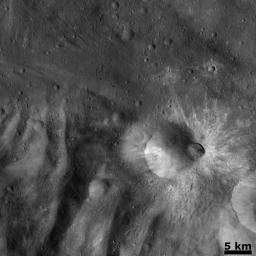
|
Recent Impact on the Rim of Tuccia Crater
- Click the image above for a larger view
- Full-Res JPEG (1024 x 1024) (158.3 kB)
- Full-Res TIFF (1024 x 1024) (1.1 MB)
Caption:
This Dawn FC (framing camera) image is dominated by the approximately 8 km diameter bright ray crater, which is roughly in the center of the image. This crater has been named Tuccia and the quadrangle in which it is located is named after it. Tuccia crater has a slightly degraded and rounded rim and is not as fresh as the approximately 3 km diameter crater located on its rim. This smaller, fresher crater must be younger than the more degraded Tuccia crater. These craters are located approximately 40 km northward of the rim of Vesta's large south polar basin. The hummocky (i.e., wavy/undulating) terrain of Vesta's south polar region is seen in the bottom part of this image. The November 16th Image of the Day, "Bright rayed craters in Tuccia quadrangle" shows roughly the same part of Vesta's surface as this image. But, today's image was acquired from a lower orbit and consequently has better spatial resolution, which means that smaller objects are now visible. Thus, tiny craters around Tuccia crater, which could not be seen in the November 16th image, are visible in this image.
This image is centered in Vesta's Tuccia quadrangle and the center latitude and longitude of the image is 36.8°S, 194.6°E. NASA's Dawn spacecraft obtained this image with its framing camera on November 8th 2011. This image was taken through the camera's clear filter. The distance to the surface of Vesta is 488 km and the image has a resolution of about 46 meters per pixel. This image was acquired during the transfer to LAMO (Low Altitude Mapping Orbit) phase of the mission.
Background Info:
The Dawn mission to Vesta and Ceres is managed by NASA's Jet Propulsion Laboratory, a division of the California Institute of Technology in Pasadena, for NASA's Science Mission Directorate, Washington D.C. UCLA is responsible for overall Dawn mission science. Dawn's VIR was provided by ASI, the Italian Space Agency and is managed by INAF, Italy's National Institute for Astrophysics, in collaboration with Selex Galileo, where it was built.
More information about Dawn is online at http://www.nasa.gov/dawn and http://dawn.jpl.nasa.gov .
Cataloging Keywords:
| Name | Value | Additional Values |
|---|---|---|
| Target | 4 Vesta | |
| System | Main Belt | |
| Target Type | Asteroid | |
| Mission | Dawn | |
| Instrument Host | Dawn | |
| Host Type | Orbiter | |
| Instrument | Framing Camera (FC) | |
| Detector | ||
| Extra Keywords | Crater, Grayscale, Impact, Infrared | |
| Acquisition Date | ||
| Release Date | 2011-11-24 | |
| Date in Caption | ||
| Image Credit | NASA/JPL-Caltech/UCLA/MPS/DLR/IDA | |
| Source | photojournal.jpl.nasa.gov/catalog/PIA15122 | |
| Identifier | PIA15122 | |
